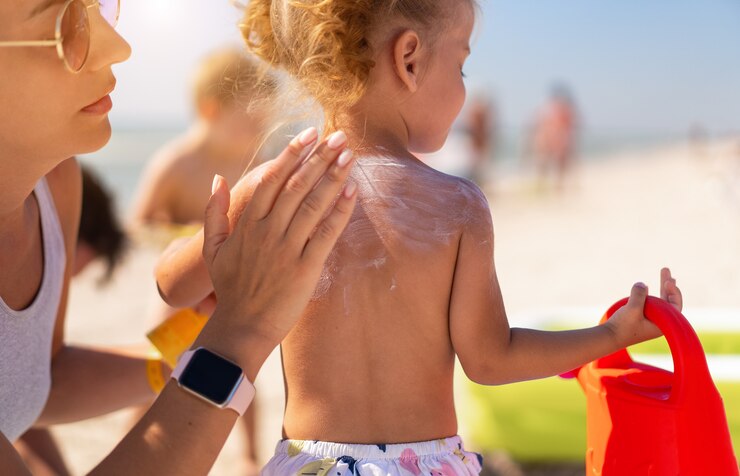Summer is the season for fun in the sun, but it can also be a nightmare for dry skin. Exposure to the sun’s harmful UV rays and intense heat can make your skin feel parched, irritated, and more prone to rashes. Protecting your skin from these summer elements is crucial, especially if you have dry skin or are prone to heat rash. Luckily, there are effective ways to safeguard your skin, and the right sun protection routine can help keep your complexion smooth and healthy.
Why Dry Skin Needs Extra Protection in the Summer
Dry skin tends to lose moisture quickly, and the intense heat and UV exposure during the summer months can make things worse. The sun’s rays dehydrate your skin, strip away its natural oils, and break down its protective barrier, leaving it vulnerable to irritation and premature aging. In addition to dryness, this can also make your skin more susceptible to developing heat rash—a condition where sweat gets trapped under the skin, leading to red, bumpy, and itchy patches.
To avoid these issues, it’s essential to take extra steps to protect your skin. Here’s how you can protect your dry skin from the harmful effects of the sun and prevent heat rash this summer.
1. Choose the Best Sunscreen for Dry Skin
If you have dry skin, the right sunscreen is your first line of defense. The best sunscreen for dry skin should not only offer high SPF protection but also have hydrating ingredients to nourish your skin. Look for a broad-spectrum sunscreen with a moisturizing formula that includes ingredients like hyaluronic acid, glycerin, or ceramides. These ingredients will help lock in moisture while protecting your skin from sunburn.
When shopping for sunscreen, opt for a product that is non-comedogenic (won’t clog pores) and free of irritating alcohols. A good sunscreen will not only shield you from UV rays but also add a layer of hydration to combat the dryness caused by the sun.
2. Avoid Peak Sun Hours
The sun is strongest between 10 a.m. and 4 p.m., which is when your skin is most at risk for damage and dehydration. If possible, try to limit your sun exposure during these peak hours. If you must be outside, ensure you’re applying sunscreen with the highest SPF, and seek shade whenever possible.
3. Use Aloe Vera or Cooling Gels After Sun Exposure
Aloe vera is a powerhouse when it comes to soothing sunburns and heat rash. After spending time in the sun, apply a generous amount of aloe vera gel or a cooling gel to your skin to help calm any irritation. Aloe vera contains antioxidants and anti-inflammatory properties that help hydrate and cool down sunburned skin, while also promoting healing. If you’re prone to heat rash, aloe vera can also provide relief from itching and discomfort.
4. Stay Hydrated with Moisturizers and Water
Dry skin can feel even more parched during the summer heat, so it’s essential to maintain moisture both inside and out. Apply a rich, hydrating moisturizer in the morning and throughout the day, focusing on areas that tend to be the driest (like your elbows, knees, and face). Look for moisturizers that contain hydrating agents like shea butter, aloe vera, or vitamin E. These ingredients help restore the moisture balance and soothe dry, irritated skin.
In addition to your topical treatments, make sure to drink plenty of water. Staying hydrated helps keep your skin plump, moist, and less susceptible to the drying effects of the sun.
5. Use a High SPF Sunscreen, Like SPF 70 Sunscreen
While SPF 30 or 50 is often the standard recommendation for sun protection, if you have dry skin or are prone to heat rash, you should consider using an SPF 70 sunscreen for added protection. The higher the SPF, the more protection your skin receives against both UVA and UVB rays. SPF 70 sunscreen will prevent sunburn for longer periods, and this is especially important for those with dry skin, as the sun’s rays can exacerbate the issue.
If you’re planning to be outdoors for extended periods, a high SPF sunscreen will give you more peace of mind knowing that you are well-protected from harmful sun exposure. Be sure to reapply it every two hours, or more frequently if you’re sweating or swimming.
6. Wear Protective Clothing and Accessories
While sunscreen is important, it shouldn’t be your only line of defense against sun exposure. To prevent heat rash and further drying out of your skin, wear lightweight, loose-fitting clothing made of breathable fabrics like cotton. This will allow sweat to evaporate and reduce the likelihood of clogged pores and rashes.
Additionally, don’t forget a wide-brimmed hat and sunglasses to protect your face and eyes from direct sun exposure. A hat will not only provide shade for your face but also prevent sunburn on your scalp and neck, areas that are often overlooked.
7. Opt for a Humidifier at Night
The dry summer air, especially in air-conditioned spaces, can further strip moisture from your skin. Using a humidifier at night can add moisture back into the air, which helps keep your skin hydrated while you sleep. This is particularly helpful if you have dry skin or experience eczema flare-ups in warmer months. Just ensure you’re using a clean humidifier to avoid any buildup of bacteria or mold that could irritate your skin.
8. Treat Heat Rash Immediately
If you do develop a heat rash, it’s important to treat it promptly to avoid irritation and further discomfort. Start by cooling the affected area with a cold compress, and apply soothing lotions or gels containing aloe vera. Avoid using products with harsh chemicals or fragrances, as they can irritate already-sensitive skin. Additionally, wear loose clothing to help the skin breathe and avoid excessive sweating.
Conclusion
Protecting your dry skin from sun exposure and heat rash this summer doesn’t have to be difficult. By selecting the best sunscreen for dry skin, using SPF 70 sunscreen for maximum protection, and incorporating a good skincare routine, you can keep your skin safe and hydrated throughout the summer months. Remember to hydrate, wear protective clothing, and avoid peak sun hours to minimize your risk of sun damage and heat rash. With the right precautions, you can enjoy the sunshine without worrying about the negative effects on your skin.



